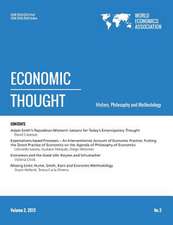Competition, Innovation, and Growth in Japan
Editat de Yuji Honjoen Limba Engleză Hardback – 22 mai 2017
| Toate formatele și edițiile | Preț | Express |
|---|---|---|
| Paperback (1) | 691.75 lei 38-44 zile | |
| Springer Nature Singapore – 9 mai 2018 | 691.75 lei 38-44 zile | |
| Hardback (1) | 787.47 lei 3-5 săpt. | |
| Springer Nature Singapore – 22 mai 2017 | 787.47 lei 3-5 săpt. |
Preț: 787.47 lei
Preț vechi: 960.33 lei
-18% Nou
Puncte Express: 1181
Preț estimativ în valută:
150.70€ • 156.75$ • 124.41£
150.70€ • 156.75$ • 124.41£
Carte disponibilă
Livrare economică 24 martie-07 aprilie
Preluare comenzi: 021 569.72.76
Specificații
ISBN-13: 9789811038624
ISBN-10: 9811038627
Pagini: 418
Ilustrații: VIII, 267 p. 40 illus.
Dimensiuni: 155 x 235 mm
Greutate: 0.6 kg
Ediția:1st ed. 2017
Editura: Springer Nature Singapore
Colecția Springer
Locul publicării:Singapore, Singapore
ISBN-10: 9811038627
Pagini: 418
Ilustrații: VIII, 267 p. 40 illus.
Dimensiuni: 155 x 235 mm
Greutate: 0.6 kg
Ediția:1st ed. 2017
Editura: Springer Nature Singapore
Colecția Springer
Locul publicării:Singapore, Singapore
Cuprins
Chapter-01:Introduction.- Part I:Competition in Japan.- Chapter-02: Competition Policy in Japan.- Chapter-03: An Empirical Analysis of the Determinants of Collusion.- Chapter-04: Is Domestic Competition Beneficial for International Competitiveness? An Empirical Analysis of Japanese Manufacturing Industries.- Part II Innovation in Japan.- Chapter-05: Measuring Innovations in firms.- Chapter-06: Organizational Design and Human Resource Management of R&D Activities.- Chapter-07: R&D Alliances and the State of Market Competition.- Chapter-08: High-tech Start-ups in Japan: The Case of the Biotechnology Industry.- Part III. Growth in Japan.- Chapter-09: E-commerce and Employment Growth in Japan: An Empirical Analysis Based on the Establishment and Enterprise Census.- Chapter-10: Market Reaction to Cross-border Acquisitions by Japanese Firms.- Chapter-11: Entry of Foreign Multinational Firms and Productivity Growth of Domestic Firms: The Case for Japanese Firms.- Chapter-12: The Stagnation of Growth Momentum in Japan and Asian NIEs: From the Perspective of Foreign Direct Investment.
Notă biografică
Yuji Honjo (Chapters 1 and 8)
Professor, Faculty of Commerce, Chuo University
His publications have appeared in Research Policy, Small Business Economics, and other journals.
Hiroyuki Odagiri (Chapter 2)
Professor (emeritus), Graduate School of Economics, Hitotsubashi University
He was the Commissioner of the Japan Fair Trade Commission and is now its Special Advisor. He has written numerous books and journal papers: The Theory of Growth in a Corporate Economy (Cambridge University Press, 1981), Growth through Competition, Competition through Growth (Oxford University Press, 1992), Technology and Industrial Development in Japan (Oxford University Press, 1996, co-authored with A. Goto), and Intellectual Property Rights, Development, and Catch-Up (Oxford University Press, 2010, co-edited with A. Goto, A. Sunami, and R. R. Nelson), to mention just some.
Masato Nishiwaki (Chapter 3)
Associate Professor, Waseda Institute for Advanced Study, Waseda University
His publications have appeared in the RAND Journal of Economics, the Journal of Industrial Economics, and others.
Masatoshi Kato (Chapter 4)
Associate Professor, School of Economics, Kwansei Gakuin University
His publications have appeared in Industrial and Corporate Change, Research Policy, and other scholarly journals.
Kenta Ikeuchi (Chapter 5)
Fellow, Research Institute of Economy, Trade and Industry (RIETI)
His publications have appeared in Telecommunications Policy and theSeoul Journal of Economics, among others.
Shoko Haneda (Chapter 6)
Associate Professor, Faculty of Commerce, Chuo University
Her publications have appeared in Research Policy, Economics of Innovation and New Technology, and other journals.
Tomoko Iwasa (Chapter 7) Associate Professor, Association of International Arts and Science Institute of Humanity and Social Science, Yokohama City University
Her publications have appeared in Research Policy and Economics of Innovation and New Technology, among others.
Hyeog Ug Kwon (Chapter 9)
Professor, College of Economics, Nihon University
His publications have appeared in the Review of Economic Dynamics, the Japanese Economic Review, and others.
Takuji Saito (Chapter 10)
Associate Professor, Graduate School of Business Administration, Keio University
His publications have appeared in the Journal of the Japanese and International Economies, the Pacific Basin Finance Journal, and other scholarly journals.
Keiko Ito (Chapter 11)
Professor, School of Economics, Senshu University
Her publications have appeared in the Journal of the Japanese and International Economies, the Review of World Economics, and others.
Hsiao-Chien Tsui (Chapter 12)
Professor, Department of Economics, National Chung Cheng University
Her publications have appeared in the Journal of Policy Modeling, Journal of Economic Psychology, and other journals.
Professor, Faculty of Commerce, Chuo University
His publications have appeared in Research Policy, Small Business Economics, and other journals.
Hiroyuki Odagiri (Chapter 2)
Professor (emeritus), Graduate School of Economics, Hitotsubashi University
He was the Commissioner of the Japan Fair Trade Commission and is now its Special Advisor. He has written numerous books and journal papers: The Theory of Growth in a Corporate Economy (Cambridge University Press, 1981), Growth through Competition, Competition through Growth (Oxford University Press, 1992), Technology and Industrial Development in Japan (Oxford University Press, 1996, co-authored with A. Goto), and Intellectual Property Rights, Development, and Catch-Up (Oxford University Press, 2010, co-edited with A. Goto, A. Sunami, and R. R. Nelson), to mention just some.
Masato Nishiwaki (Chapter 3)
Associate Professor, Waseda Institute for Advanced Study, Waseda University
His publications have appeared in the RAND Journal of Economics, the Journal of Industrial Economics, and others.
Masatoshi Kato (Chapter 4)
Associate Professor, School of Economics, Kwansei Gakuin University
His publications have appeared in Industrial and Corporate Change, Research Policy, and other scholarly journals.
Kenta Ikeuchi (Chapter 5)
Fellow, Research Institute of Economy, Trade and Industry (RIETI)
His publications have appeared in Telecommunications Policy and theSeoul Journal of Economics, among others.
Shoko Haneda (Chapter 6)
Associate Professor, Faculty of Commerce, Chuo University
Her publications have appeared in Research Policy, Economics of Innovation and New Technology, and other journals.
Tomoko Iwasa (Chapter 7) Associate Professor, Association of International Arts and Science Institute of Humanity and Social Science, Yokohama City University
Her publications have appeared in Research Policy and Economics of Innovation and New Technology, among others.
Hyeog Ug Kwon (Chapter 9)
Professor, College of Economics, Nihon University
His publications have appeared in the Review of Economic Dynamics, the Japanese Economic Review, and others.
Takuji Saito (Chapter 10)
Associate Professor, Graduate School of Business Administration, Keio University
His publications have appeared in the Journal of the Japanese and International Economies, the Pacific Basin Finance Journal, and other scholarly journals.
Keiko Ito (Chapter 11)
Professor, School of Economics, Senshu University
Her publications have appeared in the Journal of the Japanese and International Economies, the Review of World Economics, and others.
Hsiao-Chien Tsui (Chapter 12)
Professor, Department of Economics, National Chung Cheng University
Her publications have appeared in the Journal of Policy Modeling, Journal of Economic Psychology, and other journals.
Textul de pe ultima copertă
This book addresses three important concepts in the economy—competition, innovation, and growth—using various cases and available data in Japan and other countries. First, the authors discuss competition, including global competition, to provide a better understanding of competition policy in Japan. Then, the authors examine the effects of human capital and alliance on innovation while providing new innovation indicators. Moreover, the authors examine growth from the perspective of corporate strategy such as acquisition, including international comparison. The interplay of competition, innovation, and growth has been prevalent in Japan, and it still acts as a catalyst for stimulating the stagnant economy. A better understanding of competition, innovation, and growth provides the tools to reinvigorate the stagnant economy in Japan and to reinforce the economy in other countries where the period of rapid growth has ended.
Caracteristici
Highlights competition and innovation that are needed to revive a sluggish economy, such as Japan Provides new insights into growth through competition and innovation, and its policy implications Provides a better understanding of competition and innovation of Japanese firms in the current global economy


























